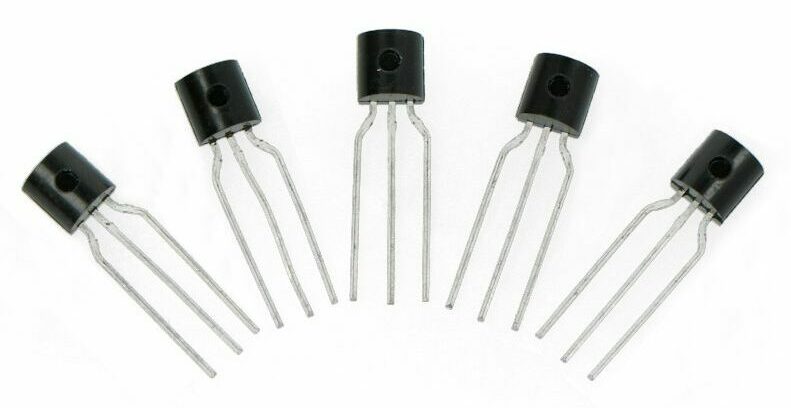Table of Contents:
BC546 is a bipolar NPN transistor used in electronics for switching and signal amplification, among other things. Its operation is based on the use of a voltage applied to the base, which controls the current flow between the collector and emitter. The structure of the transistor allows modulation of the base current. This directly affects the intensity of the current flowing from the emitter to the collector, thus enabling, precise control of the signals in the circuit. What else is the BC546 transistor used for? What electrical parameters does it have?
Basic information about the BC546 transistor
The BC546’s ability to switch quickly and efficiently makes it an ideal choice for applications requiring not only amplification, but also current control. The BC546 is characterized by stability and high efficiency, making it applicable to a variety of electronic devices, from simple circuits to complex automation systems. In addition, its ability to operate over a wide range of voltages and currents makes it an important component in the construction of consumer and industrial devices.
Construction of BC546
The BC546 transistor is constructed with three main components, namely the emitter, base and collector. Each of these parts performs specific functions in the transistor’s structure, working together to efficiently modulate and control the flow of current within the circuit.
- In an NPN transistor, the emitter releases electrons to the base, which is an intermediate element. The emitter’s job is to provide most of the charge carriers necessary for current to flow through the transistor. The emitter must be distinguished by its high efficiency in electron emission to ensure the transistor’s performance.
- The base, on the other hand, is the central part of the transistor that controls the flow of electrons from the emitter to the collector. The base is much thinner than the other parts and acts as a gate that modulates and regulates the electron current. In NPN transistors, the base must be properly positively polarized with respect to the emitter to allow the flow of electrons. This component determines the state of the transistor (on or off). This capability is crucial in switching applications.
- The collector is the electrode that collects electrons coming from the emitter through the base. In an NPN transistor, the collector is usually connected to a higher potential than the emitter to attract electrons. The collector is designed to handle a higher current than the base. Its main function is to collect and transfer current to the next parts of the circuit.
These three elements allow the BC546 to act as a switch that quickly and efficiently opens and closes a circuit. In addition, the transistor can serve as an amplifier that increases the strength of the electrical signal flowing through the circuit.
Electrical parameters
The BC546 transistor belongs to the NPN class. This means that the main current flows from the emitter (E) to the collector (C) and is controlled by the voltage applied to the base (B). In an NPN circuit, electrons flow from the emitter area to the collector area after passing through the base area, increasing the collector current depending on the voltage at the base.
- The total power of the BC546 transistor is a maximum of 0.5 watts. This is an important parameter that determines the maximum amount of energy the transistor can handle without damage.
- The maximum voltage that can be applied between the collector (C) and emitter (E) without breakthrough is 65 V. This is important to ensure safe operation of the transistor in various applications.
- The maximum collector current of the BC546 transistor is 0.1 A. This parameter determines the maximum current that can flow through the collector-emitter without damage.
- The typical range of the BC546’s current amplification factor is from 200 to 450. This amplification refers to the ratio of collector current change to base current change. Higher values of hFE indicate greater signal amplification capability.
- The BC546 transistor has a maximum switching frequency of 300 MHz. This is important for applications requiring fast signal switching.
The BC546 is available in a standard TO-92 housing known for its small size, low manufacturing cost and ease of assembly. This type of housing is commonly used in various electronic applications, making the BC546 transistor easy to implement.
Application of BC546
The BC546 is often used as a component of small-signal amplifiers in various electronic circuits. It is ideal for amplifying weak electrical signals such as audio signals in radios, audio amplifiers and transducers.
- In addition, the BC546 is used to build simple oscillators and wave generators that generate signals of a specific frequency and wave form. Thanks to its ability to operate at relatively high frequencies, the transistor is used in simple circuits that generate sine, square and triangle waves. The transistor is used in electronic clocks, in tone generators and in signal modulators.
What else is it used for?
The BC546 transistor is also used as part of signal converters that convert one form of electrical signal into another. It is used in audio signal processing circuits such as signal filters and tone balancing circuits.
Another application of the BC546 is differential amplifiers used to amplify differential input signals. Devices of this type eliminate common noise and interference components. Such amplifiers are widely used in measurement circuits, Hi-Fi audio devices and analog-to-digital converters.
The BC546 transistor is also used to construct simple pulse amplifiers used to amplify electrical pulses of short duration. Such amplifiers are used in various applications such as pulsed light sources, pulsed signal modulators and pulsed switching generators.
How useful was this post?
Click on a star to rate it!
Average rating 5 / 5. Vote count: 1
No votes so far! Be the first to rate this post.




















